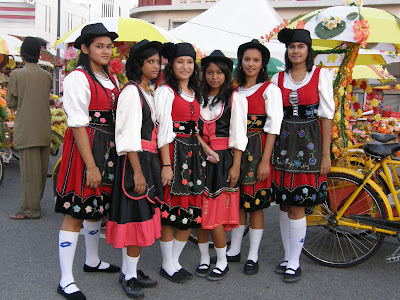TIPS UNTUK DESIGN BANNER YANG MENARIK PERHATIAN PEMBACA …
Assalamualaikum….
Sekadar pengkongsian di hari Rabu just for my own personal reference in the future…
Foreground/ Background Colors
When choosing a background for your custom design, don't use anything that will make it difficult to focus on the main message. A color wheel will show you the importance of contrast, hue and value when choosing a foreground/background color combination. Opposite colors on the wheel complement each other. For example red and green would be complementary colors. They have a good contrast, but their values are similar, so it is not the best combination.
Colors that are next to each other on the wheel, such as blue and green, make poor color combinations on your custom banner since their contrast is similar in both hue and value. It is hard to see the contrast. Alternating colors, such as blue and yellow, produce the best combinations since they have good contrast in both hue and value. Black contrasts well with any light color and white works well with colors having a dark value. For example, yellow and black are different in the contrast of both hue and value.
Highest visibility color combinations to use on your sign according to the Outdoor Advertising Assoc. of America (OAAA) is as follows:
- BLACK on YELLOW
- BLACK on WHITE
- YELLOW on BLACK
- WHITE on BLUE
- GREEN on WHITE
- BLUE on YELLOW
- WHITE on GREEN
- WHITE on BROWN
- BROWN on YELLOW
- BROWN on WHITE
- YELLOW on BROWN
- RED on WHITE
- YELLOW on RED
- RED on YELLOW
- WHITE on RED
for more info https://www.esigns.com/effective_sign_design_tips.html
------------------------------------------------------------------------------------
…….more tips as how to consider when designing a good banner and get the message we want them to know….
Choose appropriate font styles.
Avoid using more than two type styles on a banner. The more fonts used, the harder it is to read. Sans serif fonts like Helvetica, Futura and Antique Olive are the easiest to view from a distance. They should be used for the primary message on banner. Likewise, serif fonts such as Goudy, Benguiat or Times are appropriate for a secondary message. Fonts such as Old English Text or Engraved are almost impossible to read correctly from a distance and should only be used when the viewer is stationary for a period of time (such as in a conference hall, meeting room or retail store) to be able to absorb the entire message at their own pace.
Take into account the type of business or event where the banner will be used. A bridal shop or beauty salon banner can be dressed up with a script font such as Brush or Commercial Script; however, these fonts would be out of place in an auto parts business.
Also, try to stay away from using all upper case lettering on your banner. It can be used for one word or a line of text for emphasis, however, it takes the human eye longer to read and process words in upper case.
Use Graphics Appropriately
Logos, clip art, borders, etc. can effectively be used to grab the viewer's attention, but should not overpower the sign's main message. If the viewer is only concentrating on the cool clip art or graphic, the message has been lost.
As a signage professional, you have already developed an eye for what works and what doesn't. As you drive around your community, look around at all the banners vying for your attention. Notice the ones that stand out. Mentally take a note about one or two elements of the banner design that grabbed your attention in the first place.
Consider viewing distance and viewing time.
Always ask your customers, "How far away will the banner be from the viewer?" If a grand opening banner will be on the front of a business with a large parking lot between the storefront and the street, the letter height must be large enough to be viewed by drivers on the street. Also, keep in mind that a driver only has about 1.5 - 3 seconds to read a message while in motion. The chart below will help determine the correct height vs. viewing distance.
Banners need margins and white space.
Margin widths are usually the most abused spaces on a banner. Common errors include stretching letters and graphics to fill the entire banner to the edges, or the text and graphic is too small for the sign and the margins are too big. A general rule of thumb is to have the top and bottom margin be 10% of the height, and right and left margins be at least as wide as one of the banner's main font character width. For example, a 48" sign should have a 4.8" top and bottom margin. A three-foot wide banner should have at least a 3" margin on the top and bottom. Avoid filling the empty spaces of the banner with graphics. White space helps keep the viewer's eyes concentrated on the text.
more info http://www.signindustry.com/banners/articles/2004-03-15-GIA-SignDesign101.php3
…thats all for today…..


Comments